Patient safety – the focus for all Competent Authorities for Medical Devices (CAMD) members
By Andrew Queen / On December 10th, 2018 / In Health, Other, Regulatory, Wellbeing

The regulation of medical devices, both worldwide and within the EU, is in its relative infancy and has been evolving over many years. Many products that were placed on the market in past years would not meet present day requirements and new legislation is designed to address this. Equally, hundreds of thousands of diverse medical device technologies are saving lives and bring huge benefits to patients and health care in Europe every day. Devices are often used in critical surgeries and procedures. Whilst they bring great benefits a fact-based judgement is the key to make sure that the benefits justify any risks and this equation is often a very individual one for patients in discussion with their clinician
All European Competent Authorities (CAs) work together in the Competent Authorities for Medical Devices (CAMD) network to promote patient safety through the consistent development and application of the medical devices regulatory system.
This work has included implementation of wholesale reform of the process of managing Notified Bodies in order to both raise and harmonise standards of performance as a result of the Joint Plan for Immediate Action in 2012. There has also been a substantial upgrade of the requirements for clinical evidence which were published in 2016.
The CAMD worked closely with the European Commission to identify major areas of the current legislation, which has been in place for more than 25 years, and which are in need of revision and developed to account for technological developments, identified inconsistencies or weaknesses. The new EU Medical Devices Regulations which are on course for full implementation by May 2020 will:
- reinforce and introduce much more stringent requirements for high risk and implantable medical devices and increase scrutiny by regulators and independent clinical experts of high-risk devices
- increase requirements for notified bodies for medical devices and enhance mechanisms for designation, oversight and challenge of performance
- increase transparency throughout the regulatory system including the establishment of a comprehensive EU database on medical devices where parts of it are public (safety information, device information, regulatory information)
- reinforce the rules on clinical evidence and its evaluation throughout a product’s lifetime
- strengthen the post-market surveillance requirements for manufacturers
- increase responsibilities for CAs in the fields of vigilance and market surveillance and improve coordination mechanisms between EU countries on these activities.
The CAMD is playing a key role in transition to the new EU Medical Device Regulations and has published the MDR/IVDR roadmap to provide an overview and priority listing of all the Commission’s and national competent authorities’ expected initiatives (including guidance) during the transitional period.
European Joint Action projects, funded by the European Health Programme, are also in progress aiming to reinforce the market surveillance system for medical devices by improving the coordination of activities by all CAs, and ensuring adequate communications and cooperation.
The primary goal of the CAMD is to enhance collaborative working and consistency across the network to increase both effectiveness and efficiency and ensure the proportionate and consistent application of the legislation in the best interests of patients and health systems.
Back to news